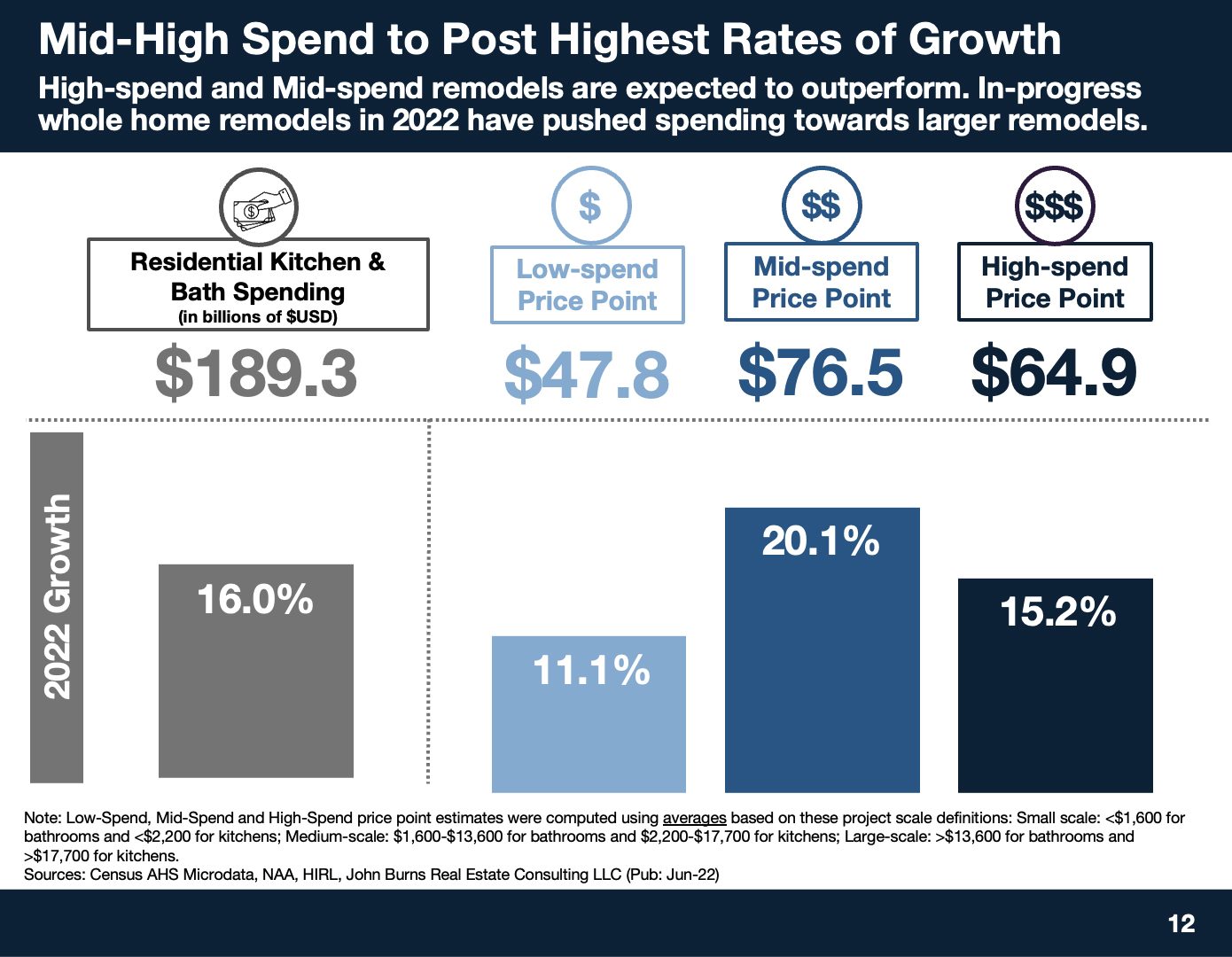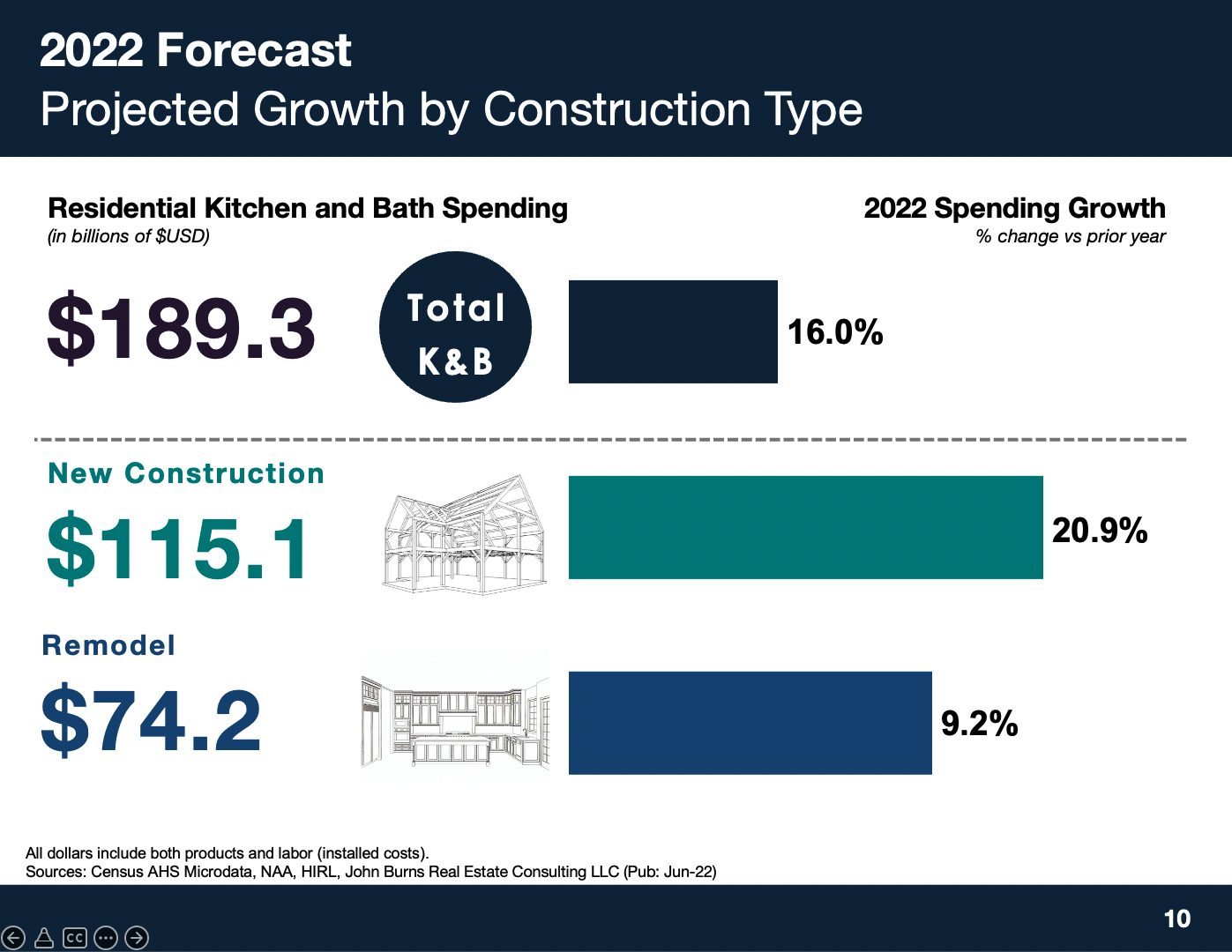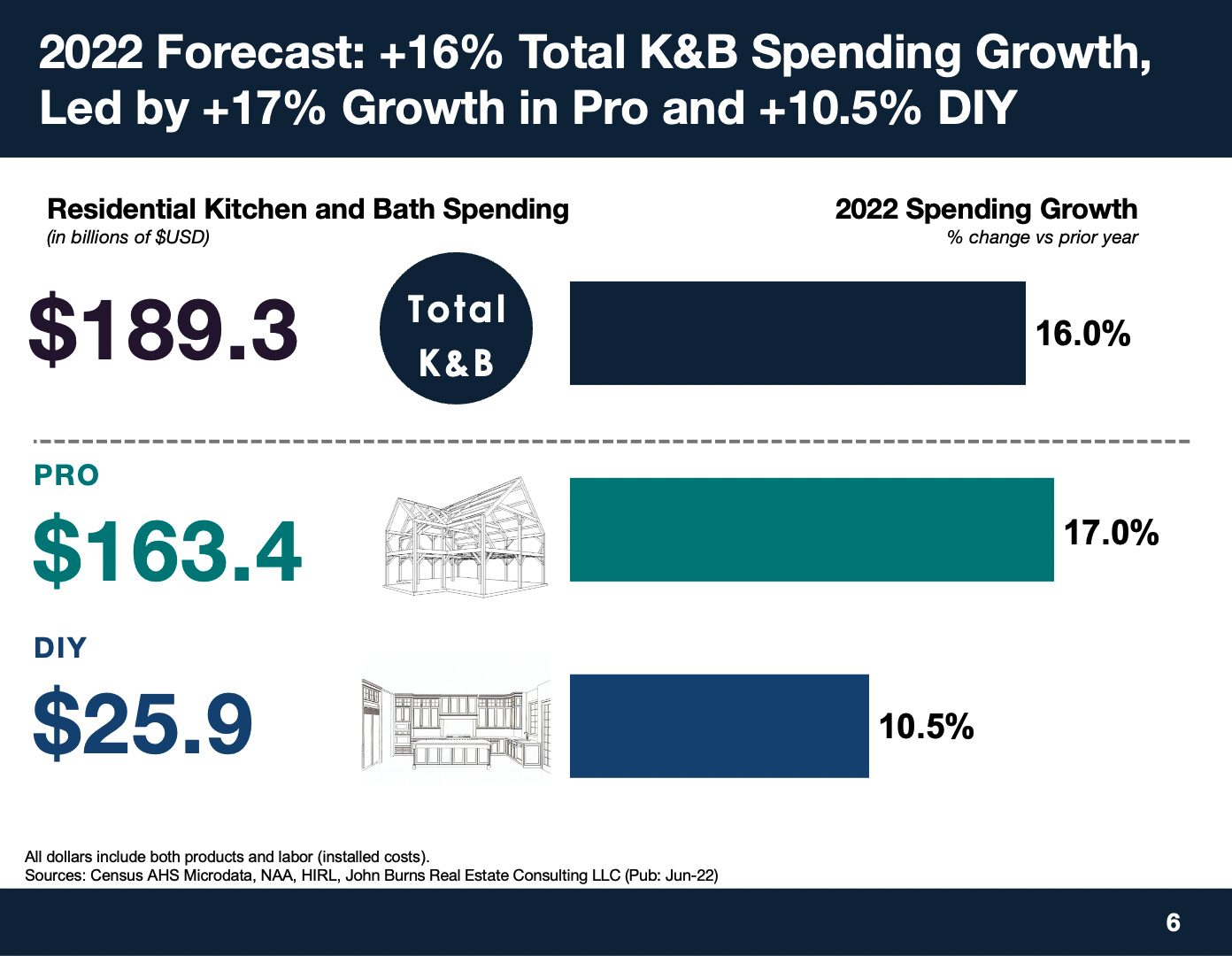By Natalie Forster
Bath & kitchen market outlook
Economic indicators for both the residential and commercial sectors.
Video courtesy of KanawatTH / Creatas Video+ / Getty Images Plus. Plue, use of. the following images: Residental bath photo courtesy of Nadore / iStock / Getty Images Plus Residential kitchen photo courtesy of LEK_3DPHOTO / iStock / Getty Images Plus Commercial kitchen photo courtesy of onurdongel / iStock / Getty Images Plus Commercial bath photo courtesy of Nadore / iStock / Getty Images Plus
According to the 2022 Kitchen and Bath Market Outlook, conducted by the National Kitchen and Bath Association (NKBA), full-year industry revenues are expected to reach $199 billion by the end of 2022.
Both the residential and commercial new construction and remodel sectors have experienced significant demand throughout the past two years. Pent up demand, coupled with inflation, societal shifts and other economic factors have led to revenue growth for bath and kitchen professionals throughout every level of the supply chain.
Although residential construction and remodel has been booming, there may be a shift happening.
The Plumbing, Heating and Cooling Contractors Association (PHCC) Business Intelligence Team recently published its PHCC Market Outlook, which reports that over the next five years, the commercial sector is predicted to see modest growth while the residential sector will some decline.
IBISWorld reported in January 2022 that the value of residential construction is projected to drop by .94% in 2027 to $662.5B, down from $694B in 2022 while the value of nonresidential construction value is expected to increase by 1.78% in 2027 to $505B from $463B in 2022. IBISWorld noted that “the eventual recovery from the virus crisis will likely provide a big boost to investment, with nonresidential structures likely being updated or built to match shifting manufacturing activity and other reshoring operations.”
Though a boom in commercial construction is expected, it is possible that both sides of the market will see a slight decline throughout 2022 and beyond.
Residential outlook
When discussing when or if the housing market will boom or bust, The American Supply Association’s (ASA) Chief Economist, Dr. Chris Kuehl noted in his recent podcast, “Keeping it Real with Dr. Kuehl” that he does not expect a housing market bust at a national level anytime soon.
“We are still about five million homes short of what’s needed nationally,” he said. “We only build about 1.5 million homes a year, so we are likely five years out from even thinking about being caught up with current demand.”



Kuehl explained that when honing in on specific geographic markets, though, it is possible to see some busts.
“We have really hot markets in areas like Austin, Texas, Phoenix, Arizona and Nashville, Tennessee, but other areas of the country aren’t seeing nearly that amount of demand as these examples,” he said.
The long-term impacts of COVID-19 are certainly affecting the housing market. Kuehl explained that one of the driving factors of housing markets in a certain area was the labor market. But now, as many companies are offering 100% remote work, people can live wherever they want to, even if the job market in that area is not the best.
This flexibility is leading to infrastructure issues in some popular areas. “Cities like Austin are bursting at the seams, and it’s taking a toll on the infrastructure,” Kuehl explained. “The number of people moving in has exceeded the capacity in terms of highways, number of fire and police stations, water infrastructure and more.”
In short, Kuehl said that the national housing market has come off of its peak, but it is still higher than it has been in the past five or six years, meaning demand will continue to be high for the foreseeable future.
The U.S. is still about five million homes short of what's needed to meet demand.
Over the past few months in early 2022, concern has arisen around rising mortgage rates. Kuehl says that while they are rising at the FED level, it’s not to alarming rates.
“There has been no evidence that the FED intends to raise interest rates to five, six or seven percent,” he said.
“There are still a lot of projects to be done,” Kuehl said. “There is still plenty of opportunity for PHCP-PVF professionals to take advantage of; the question ahead is exactly where in the country that opportunity lies.”
Judy Kimble, director of sales and marketing, kitchen and bath for First Supply agrees that paying close attention to geography is key. “In the upper Midwest, we continue to experience solid growth in residential, single-family, over 55 zero lot line communities, multi-family and remodel. We simply do not have enough homes. The majority of our 19 stores are located in Wisconsin,” she says. “Wisconsin home prices are increasing at the fastest rate in 15 years. Homes are being sold within 24-48 hours with no contingencies. The million-dollar question is, where do the sellers go?”
When it comes to the residential remodel market, Kerry Stackpole, CEO and executive director of Plumbing Manufactures’ International (PMI) says PMI anticipates continued demand from homeowners. “Consumers overall are in a really strong position,” he says. “They have some money saved up from all of the time during COVID they weren’t spending on travel and services, and nationwide, credit card debt is down a bit, so some consumers are in a position to take on new debt to complete remodel projects.”
Stackpole also points to the infamous labor shortage, which is creating an even deeper backlog of residential remodel projects that will need to be done in 2022. “Many homeowners want remodel projects done, but can’t get a professional out to do them because of the shortage of contractors,” he notes. “This, coupled with long lead times on certain products due to supply chain issues, has pushed some projects back months and months, meaning the demand is still high.”
Dario Cazares, corporate director of showrooms, Crawford Supply Co. says the remodel market is continuing to be fruitful. “Opportunity is everywhere, but I’m most excited to see the residential remodel market continue to perform well. End users are the perfect candidates for a dedicated showroom consultation, so their project goes well. Having an expert in your corner to help navigate supply chain issues is of great value right now.”
So, we know homeowners are still remodeling their homes. What types of projects are they investing in?
The PHCC Business Intelligence Team reports that water conservation is top of mind. “IBISWorld reported that as businesses and families become more concerned about water usage, and as droughts remain an issue for some parts of the country, green services are forecast to become a more essential segment of the industry's offerings, an emphasis on energy and water management will lead to the replacement of older plumbing and heating systems. Given some stagnation in the residential construction sector and current volatile economic conditions, homeowners may elect to stretch the useful life of appliances and plumbing equipment like water heaters.”
Current demand for residential housing projects largely depends on geographic location.
Amy Mack, corporate showroom manager at Consolidated Supply Co. brings up another rising trend — aging in place. “I think an area of opportunity in our showrooms and market is living in Place. We do sell grab bars and some other ADA products, but I think the market is much bigger with referral programs such as what LIXIL offers,” she explains. Fold-down seats, ADA decorative towel bars, toilet paper holders. Delta/Brizo and Moen offer such items but companies such as Invisia specialize in a broad range of products that look like they belong in a spa bathroom than an institution.”
Merging the ever-popular touchless technology with a desire for more efficiency and conservation remodels to include smart home products is a huge desire for end-users. “Consumers are beginning to make the connection between energy and water efficiency,” Stackpole notes. “So we’re seeing a drive toward more smart home connected products — products that measure a tablespoon of water from your faucet — and that trend will continue as people continue to invest in making their spaces more efficient.”
Commercial outlook
Much has changed over the past couple of years in commercial spaces. The PHCC Business Intelligence team anticipates commercial growth the be but stagnant until 2023.
“FMI’s 2021 North American Engineering and Construction Outlook reports that with lower vacancy and unemployment rates, segments like lodging, office buildings, educational, religious, and retail sales will not see growth until 2023,” the team reports. “Segments such as healthcare, data centers, home improvement, public safety, and single-family and multifamily residential will see modest growth late in 2022 assuming increased consumer and business sentiment along with expanded investments. Parenthetically, infrastructure investments will account for growth in construction in 2022 with the $1.2 trillion Infrastructure Investment and Jobs Act.”
Commercial projects such as healthcare, data centers and multifamily are expected to see modest growth throughout the rest of 2022.
Stackpole too brings up the impact of the infrastructure bill. “We have the benefit of the Biden Administration’s focus on infrastructure, which will drive some projects related to clean and safe water over the coming years,” he says.
Commercial buildings such as data centers, distribution centers and warehouses are in high demand.
“The commercial market should see demand again from projects which were postponed during the height of the pandemic and the height of the supply chain disruption,” says Stackpole. “The increased interest in energy and the IoT is driving the need for data centers and logistics centers.”
Both residential and commercial projects will see growth due to pent up demand from projects postponed due to COVID and supply chain issues.
Kimble notes there is also a lot of growth in the hospitality sector, which will continue to drive demand for commercial bath and kitchen products and projects.
Amazing, frenetic and fabulous
All in all, bath and kitchen professionals can anticipate another plentiful year in both the residential and commercial markets, but be sure to keep an eye on a few moving factors.
Inflation is a top concern among experts. “Inflation is the number one concern. Pressure on that front could close wallets rapidly. New vehicles are still difficult to obtain, but vacations and getaways are back on the table,” Crawford Supply’s Cazares says.
PHCC’s Business Intelligence Team agrees: “Consumer discretionary spending fluctuates based on economic conditions. Therefore, with inflation at 7.9 percent in February, rising costs, rising interest rates, and higher energy costs, homeowners may elect to delay bath and kitchen remodeling until savings can be replenished and credit card debt declines. According to the University of Michigan consumer sentiment for the US, outlook fell from 62.8% to 59.7% in March 2022.[1] The better news is that Trading Economics suggests that “The United States Michigan Consumer Sentiment is projected to trend [upward] in 2023’ barring the beginning of an anticipated recession in 2024.”
When asked to describe the bath and kitchen market today in one word: Phenomenal, frenetic and amazing were words experts chose to use.
“Frenetic. Demand is strong, supply is shaky, staff are tired but dedicated to the task at hand,” Cazares says. “I hope conditions continue to improve as we trek forward.”
Stackpole describes the bath and kitchen market as fabulous.
“We're in this moment in the plumbing industry where the innovation and creativity that's being deployed is just phenomenal,” he says. “And these innovations are being done in a socially responsible way. The best marriage is having a product that you can produce a high-performing product that consumers love that also protects the environment; our industry is doing that and that’s the best of both worlds in my book.”
1 Trading Economics, United States Forecasts, retrieved from the World Wide Web on March 8, 2022 at https://tradingeconomics.com/united-states/consumer-confidence





